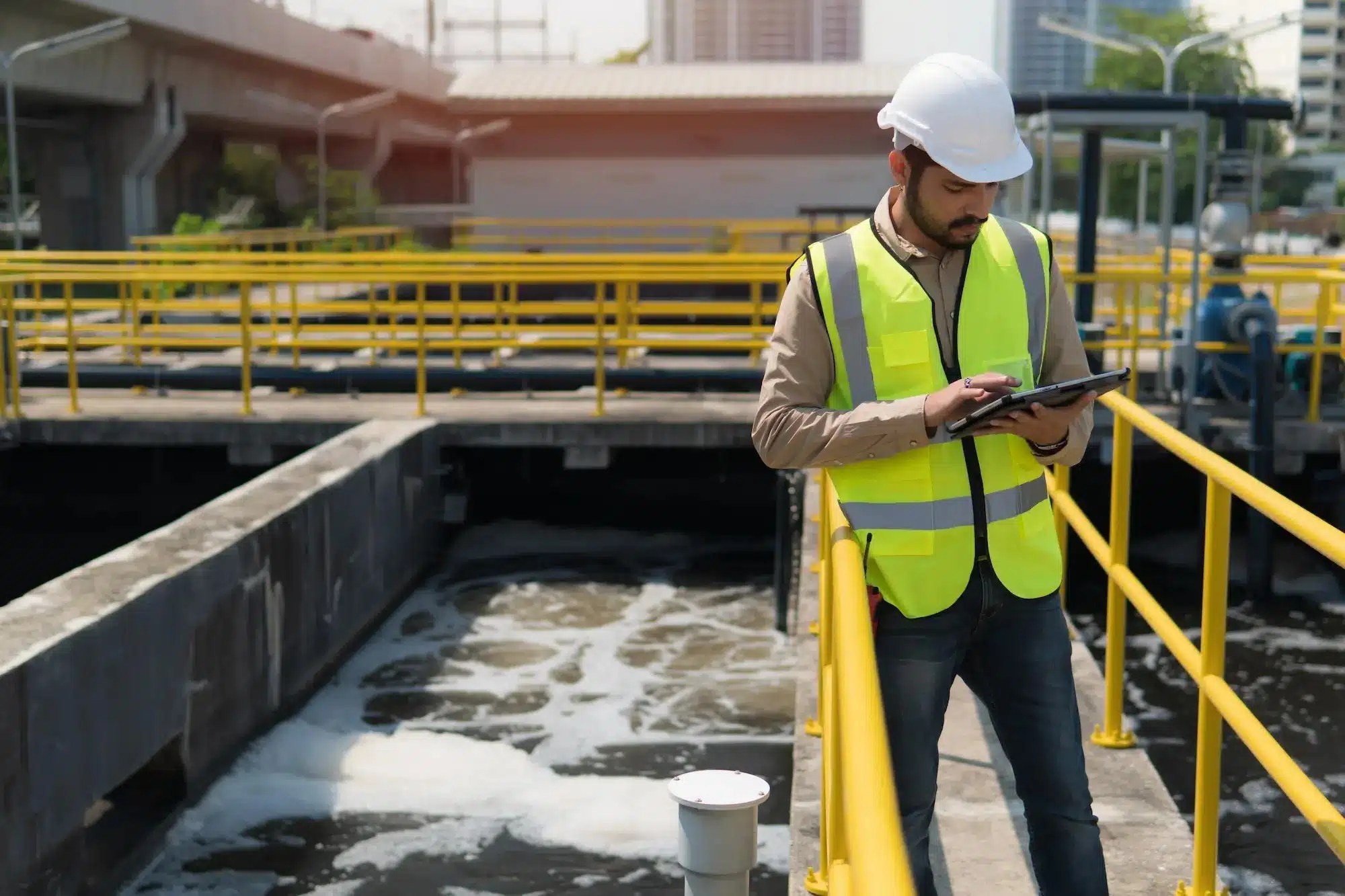Originally designed to enhance the precision and efficiency of water meter readings, Advanced Metering Infrastructure (AMI) offers capabilities that go well beyond its initial purpose. By broadening the use of AMI, we can tackle many urgent issues in our water infrastructure, such as resource conservation, operational efficiency, and improved customer engagement.
Understanding AMI

Advanced Metering Infrastructure (AMI) refers to an integrated system of smart meters, communication networks, and data management systems that enable two-way communication between utilities and customers. This infrastructure facilitates real-time data collection and analysis, offering valuable insights that can enhance water management practices. AMI provides numerous benefits to water utilities, including the ability to gather frequent and accurate water usage data, which improves billing, leak detection, and water resource management.
Traditionally, AMI automated meter reading, reducing the need for manual readings and minimizing human error. This led to more accurate billing and better leak detection. However, AMI’s capabilities extend far beyond these initial applications.
Over time, water meters have evolved. Older technology required technicians to visit individual sites to read meters manually. With the advent of automated meter reading (AMR), meters allowed data collection to be done remotely, such as by driving a truck down a street and gathering data from nearby meters. This reduced staff time and enabled more frequent billing. Some argue that this led to more accurate readings and lower bills for some customers, while others felt their bills increased.
As electricity providers have updated their meters, water utilities are following suit. AMI meters allow for remote, real-time data collection, enabling frequent billing and swift identification of excessive water use due to leaks. Leaks are a significant issue globally; the U.S. EPA reports that the average family can waste 180 gallons of water per week, or 9,400 gallons annually, from household leaks, enough to wash over 300 loads of laundry.
According to IBM, AMI helps utilities gather important data, including tampering indications, interval data, power outage details, and electricity quality. It also provides advanced capabilities for electric metering endpoints.
Unlike traditional automatic meter reading, AMI’s two-way communication enables comprehensive data collection, allowing companies to manage meter functionality remotely. Communication networks, either wireless or wired, carry data between smart meters and the AMI system, enabling remote commands for disconnecting, reconnecting, or firmware updates.
These networks transmit usage information to water, gas, and electric utilities using radio frequency signals, cell networks, broadband, or power line communication (transmitting data over power lines). Remote meter management not only eliminates manual readings but also ensures faster response times during power outages or other issues.
SiteMap® (patent pending), powered by GPRS, offers a platform for crucial data, including aggregated, annotated maps, as-builts, and photos. Anyone who orders a GPRS locate job receives a complimentary basic SiteMap® account, which is user-friendly and accessible from any device, anywhere.
The Need for Modernizing Water Infrastructure
Water infrastructure in many parts of the world is aging and in dire need of upgrades. In the United States alone, the American Society of Civil Engineers (ASCE) gave water infrastructure a grade of C- in its 2021 infrastructure report card, underscoring the urgent need for investment and modernization. Outdated infrastructure leads to frequent water main breaks, substantial water loss through leaks, and inefficient water use, among other serious issues.
With growing populations, climate change, and increasing demand for water resources, the pressure on existing infrastructure is escalating. Innovative solutions are essential to advance our water systems, and this is where an expanded view of Advanced Metering Infrastructure (AMI) comes into play.
When AMI is implemented, utilities can easily manage resources and detect leaks before they become significant problems. This not only leads to cost savings but also helps reduce water waste and improve overall efficiency.
AMI for Water Management

Leak Detection and Prevention
One of the most immediate and impactful applications of AMI is in leak detection and prevention. Water loss through leaks is a major issue for many utilities, with some systems losing up to 30% of their water supply.
The World Bank suggests that on average up to 25-30% of a utility’s water is lost in the network as non-revenue water (NRW). Small leakages worldwide are estimated to cost $14 billion per year to utilities. This is not only an issue financially, but also for things like water conservation. Leaks are a pretty large problem for many countries. In the U.S., an estimated 2.1 trillion gallons of water are lost per year due to leaks. That’s the equivalent of tsunami, and it has nearly just as much potential to destroy a community.
Detecting water leaks is important, which is why GPRS recommends regular water loss surveys conducted by our leak detection services as a preventative measure. The more of your subsurface utilities you have mapped, the better you’ll be able to track their stability. By the time a leak becomes apparent, you’re already risking damage to your infrastructure and thousands of dollars in repairs and non-revenue water loss (NRW). Regular water loss surveys help you find leaks before they become emergencies. Routine checkups help:
- Assesses pressurized subsurface water systems
- Pinpoints and marks out any leaks detected
- Allows for planning, targeted repair, and maintenance with minimal excavation
Your GPRS Project Manager can accurately map any pressurized water system, fire loop, or sanitary and storm sewer systems, and other utilities if needed, and provide you with a complimentary PDF and .KMZ file, along with your Leak Detection Report, delivered via SiteMap®. Every GPRS customer receives a complimentary SiteMap® Personal subscription as part of their package.
AMI systems are a fantastic resource, especially when used in conjunction with subsurface utility mapping and regular water loss surveys. AMI systems, with their real-time monitoring capabilities, can quickly identify anomalies in water usage that may indicate leaks. By analyzing data patterns, utilities can pinpoint the location of leaks with high accuracy, allowing for prompt repairs. This not only conserves water but also reduces the costs associated with lost water and infrastructure damage.
Demand Management and Conservation
AMI can play a crucial role in managing water demand and promoting conservation efforts. By providing detailed data on water usage patterns, utility managers can implement targeted conservation programs. For instance, during extended droughts, utilities can use AMI system data to identify areas with high water usage and encourage or enforce conservation measures, like actions taken in California, where droughts are frequent and severe.
AMI also enables the implementation of tiered pricing structures, which incentivize water conservation by charging customers different rates based on their usage levels. This approach encourages more efficient water use. Electricity providers like DTE in Michigan have implemented similar programs, charging different rates throughout the day. Additionally, real-time feedback through AMI-enabled devices allows consumers to monitor and adjust their water consumption, fostering more sustainable practices.
Enhanced Operational Efficiency
Operational efficiency is a critical component of modernizing water infrastructure. AMI can greatly enhance the efficiency of water distribution systems by providing utilities with a comprehensive view of their operations. Real-time data on water flow, pressure, and quality allows for proactive system management.
For example, utilities can optimize pump operations to reduce energy consumption and extend equipment lifespan. By monitoring pressure levels, they can identify and address issues before they become major problems. AMI also facilitates predictive maintenance, enabling utilities to schedule repairs and replacements based on actual usage and wear, rather than relying on fixed schedules. This adaptability helps promote conservation across the board.
Smart metering capabilities, such as AMI meters, are significantly improved by accurate utility mapping. These systems often need to be installed after utility line replacements to ensure safety and functionality. GPRS supports these advancements with 99.8% accurate utility locating services, making these technological improvements possible.
Improved Water Quality Monitoring
Ensuring water quality is a top priority for utilities, as contaminants and pollutants can enter the water supply from various sources, posing serious health risks to consumers. Traditional water quality monitoring methods, which involve periodic sampling and laboratory analysis, can delay the detection of issues.
AMI can transform water quality monitoring by providing continuous, real-time data on water conditions. Smart sensors integrated into the AMI network can detect changes in parameters such as pH, turbidity, and the presence of harmful substances. This allows utilities to quickly respond to anomalies, minimizing the risk of contamination and ensuring the water supply’s safety. However, this should not be seen as the sole solution; a robust system of checks and balances, including traditional testing methods, is essential to ensure the most accurate monitoring.
Customer Engagement and Transparency
Customer engagement is a crucial element in successfully implementing water management strategies. AMI provides a platform for enhanced transparency and communication between utilities and customers. Through user-friendly interfaces and mobile applications, consumers can access real-time information about their water usage, billing, and conservation efforts. Some platforms even allow customers to pay for their water bills in increments, seeing their daily usage and opting to pay for it that day. This system can be more manageable for some customers and provides a clear picture of their usage, enabling them to adjust their habits accordingly.
This transparency builds trust and encourages consumers to take an active role in water conservation. Utilities can also use AMI data to educate customers about efficient water use practices and the impact of their consumption on the overall system. By adopting a collaborative approach, utilities and customers can work together to achieve sustainable water management goals.
Case Studies and Success Stories
Several utilities around the world have already begun to harness the power of AMI to transform their water infrastructure. These case studies provide valuable insights into the potential of AMI and serve as models for other utilities considering similar initiatives.
Singapore’s Smart Water Grid
Singapore has long been a leader in water management, and its adoption of a smart water grid is evidence of its commitment to innovation. The Public Utilities Board (PUB) of Singapore has implemented an extensive AMI network and smart grid that covers the entire island. This system provides real-time data on water usage, pressure, and quality, enabling proactive management and rapid response to issues.
Through its smart water grid, Singapore has achieved significant reductions in water loss, improved operational efficiency, and enhanced customer satisfaction. The success of this initiative highlights the potential of AMI to drive transformative change in water infrastructure.
City of Houston’s WaterSmart Program
The City of Houston, Texas, has implemented the WaterSmart program, using smart systems like AMI to promote water conservation and improve customer engagement. The program provides customers with real-time access to their water usage data through a user-friendly portal. Customers receive alerts about potential leaks and personalized recommendations for reducing water consumption.
Since its launch, the WaterSmart program has achieved impressive results, including a substantial decrease in water usage and heightened awareness about water conservation. By empowering customers with data and insights, Houston has created a culture of sustainable water use. There is even a drought data visualization tool powered by this program, allowing users to learn more thanks to the data collected.
Since January 2021, Reclamation has selected 666 projects to be funded with $292.6 million in WaterSMART funding, in conjunction with $2.2 billion in non-Federal funding, across the western states.
The Future of Water Infrastructure with AMI

We will continue to grapple with water scarcity, climate change, and aging infrastructure. Our need for innovative solutions becomes increasingly urgent, yet too few innovations emerge each year to meet this demand. However, AMI represents a powerful tool that can help address some of these challenges and pave the way for change.
The potential of AMI extends far beyond its initial applications. By embracing technologies like AMI, utilities can unlock new possibilities for leak detection, demand management, operational efficiency, water quality monitoring, and customer engagement. However, realizing this potential requires overcoming challenges and ensuring proper utility mapping first. Many miles of infrastructure are inaccurately mapped and in desperate need of a complete overhaul.
SiteMap® helps project managers, conservationists, and other professionals visualize utilities both above and below ground. Once accurately located, these utilities can be replaced or upgraded with smart technologies like AMI. Routine locating and mapping services, such as those provided by GPRS, in conjunction with AMI and other technologies, can help transform our current infrastructure for the better.
Through collaboration, investment, and a commitment to innovation, society and those who map it can utilize the power of AMI to transform water infrastructure and ensure the sustainable management of this precious resource for generations to come. As we move forward, we must leverage as much technology as possible to change how we view and interact with our utilities. If we want a surge of progress, we’ll need to open the faucet.
GPRS SiteMap® team members are currently scheduling live, personal SiteMap® demonstrations. Click below to schedule your SiteMap® demo today!
